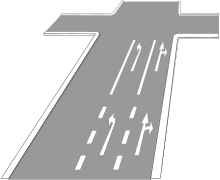Turning lanes
A turning lane (colloquially also turning lane ) is a lane for vehicles turning on a road . In Germany , for example, this lane must be at least 2.75 m wide . Only then may this lane be separated from the other lanes with a marking . This width is necessary so that the traffic can continue to flow on the other lane without hindrance if there is a truck there.
Right and left turn strips
In addition, a distinction is made between the turning lane for those turning left and right. If there is not enough space to build a lane for turning left and right, the principle applies that one should dispense with the right-turning lane in favor of the left-turning lane, as turning left is often hindered by oncoming traffic and so quickly congestion can occur. A right-turning lane is only to be implemented if the strength of the turning current is sufficiently large and a high speed is being driven on the higher-level road. Another reason for a right-turn lane can be the lack of visibility of the junction.
If there are larger streams of left turns, sufficient storage space must be made available. For this reason, the left-turn lane is provided with an installation section. The length of the installation section is between 10 and 20 meters, depending on requirements.
Components
Turning lanes consist of the following elements, depending on the turning current, junction speed and available traffic area:
- Warping distance (warping of the lane from two to three lanes, for example)
- Deceleration distance (distance on which the speed can be reduced before turning)
- Installation distance (length of the storage space at the junction)
Exit wedge
Another option for guiding right turns is the so-called exit wedge. This 35 m long exit opening meets driving dynamics requirements and, unlike the lane turning right, has no delay section. The exit wedge is used when the number of right-turns is low and the junction speed is low, making a right-turn lane unnecessary. To better separate the traffic flows, a triangular island is placed at the end of the extension wedge.
See also
Norms and standards
- Guidelines for the construction of roads - Part: Junctions (RAS-K)
- Guidelines for the construction of roads - Part: Cross-section (RAS-Q)
Individual evidence
- ↑ Basic dimensions of motor vehicles defined in the Road Traffic Licensing Regulations
- ^ Wolfgang Pietzsch: Street planning, Werner Verlag, ISBN 3-8041-2949-8 , page 225

